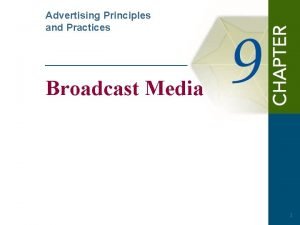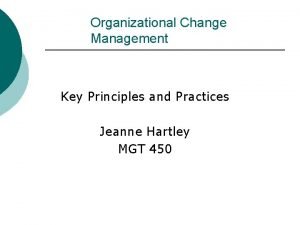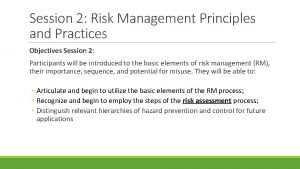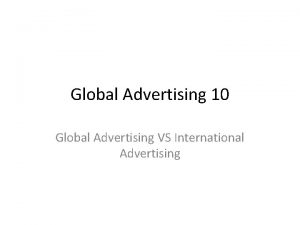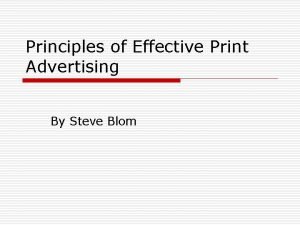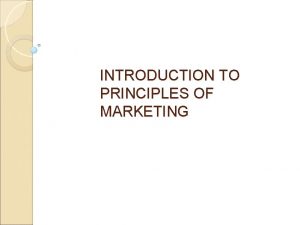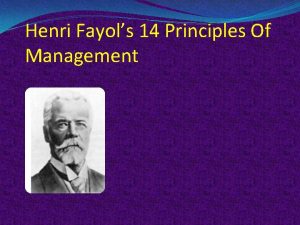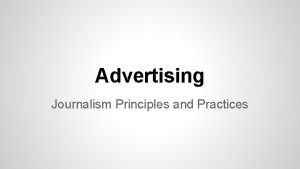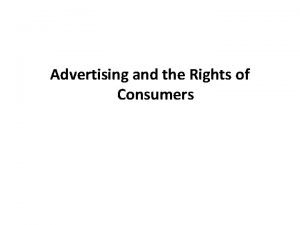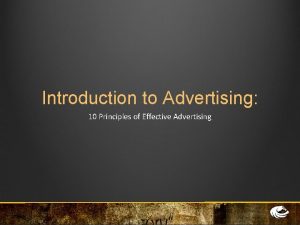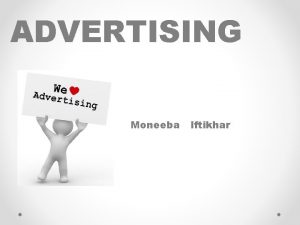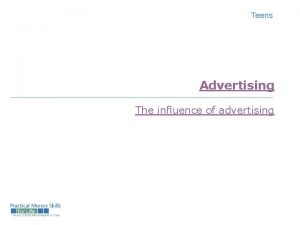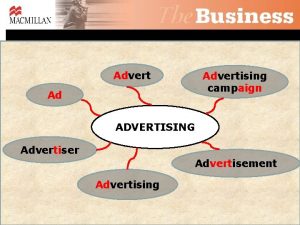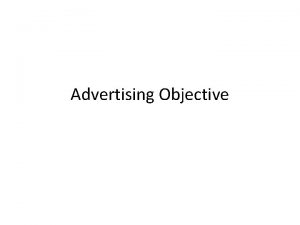Advertising Principles and Practices Introduction to Advertising WHAT































- Slides: 31

Advertising Principles and Practices Introduction to Advertising

WHAT IS ADVERTISING? Defining Modern Advertising • Advertising is a paid persuasive communication form that uses nonpersonal mass media- as well as other forms of interactive communication- to reach broad audiences to connect an identified sponsor with a target audience. Prentice Hall, © 2009 1 -2

Defining Modern Advertising Five Basic Factors of Advertising 1. Paid communication 2. Sponsor is identified 3. Tries to inform or persuade 4. Reaches a large audience 5. Message conveyed through many different kinds of largely non-personal mass media Prentice Hall, © 2009 1 -3

Four Components of Advertising Prentice Hall, © 2009 1 -4

Four Components of Advertising 1. Advertising Strategy • The strategy is the logic and planning behind the ad that gives it direction. • Advertisers develop ads to meet objectives. • Advertisers direct ads to identified audiences. • Advertisers create a message that speaks to the audience’s concerns. • Advertisers run ads in the most effective media. Prentice Hall, © 2009 1 -5

Four Components of Advertising 2. Creative Idea • The creative concept is the central idea that grabs the consumer’s attention and sticks in memory. • Planning strategy requires creative problem solving. • Research involves creativity. • Buying and placing ads requires creative thinking. Prentice Hall, © 2009 1 -6

Four Components of Advertising 3. Creative Execution • Effective ads are well executed reflecting the highest production values in the industry. • Clients demand the best production the budget allows. Prentice Hall, © 2009 1 -7

4. Media Four Components of Advertising Planning/Buying • Television, Internet, magazines, and other media are used to reach a broad audience. • Deciding how to deliver the message requires creativity. Prentice Hall, © 2009 1 -8

Four Roles of Advertising 1. The Marketing Role • Marketing is satisfying customer wants and needs by providing products (goods, services, and ideas). • The marketing department is responsible for selling the product using the 4 Ps (product, price, place/distribution, and promotion) and brand development. Principle: A product can be services and ideas as well as goods. Prentice Hall, © 2009 1 -9

Four Roles of Advertising 2. The Communication Role • Advertising is a message to a consumer about a product, designed to create a response. • It is also a form of marketing communication. • Advertising uses mass communication to transmit product information to connect buyers and sellers in them marketplace. Principle: One of advertising’s most important strengths is its ability to reach a large audience. Prentice Hall, © 2009 1 -10

Table 1. 1 The Strengths of Advertising Strengths Examples Can reach a large audience A commercial in the Super Bowl can reach more than 100 million consumers. Introduces products and brands The “ 1984” commercial for the Apple Mc. Intosh sold out the entire inventory in one day. Builds awareness of products and brands The success of the launch of the i. Pod was due in part to the great silhouette posters that showed people dancing to the music on their i. Pods. Creates brand images The success of the new VW Beetle was largely built on its ability to connect with the anti-status image of the original “lowly” Beetle. Provides information The truth® campaign informs teens that “Tobacco kills 1, 200 people a day. ” Reminds and reinforces Procter & Gamble’s Ivory Soap has been advertised continuously since the late 1800 s. Persuades Nike campaigns, with the “Just do it” personal achievement message, have helped increase sales by 300 percent during the 1990 s. Prentice Hall, © 2009 1 -11

Four Roles of Advertising 3. The Economic Role • Because it reaches large groups of people, advertising makes marketing more costefficient and lowers prices for consumers. • Advertising creates a demand for a brand using hard sell (persuading) and soft sell (image building) techniques. Prentice Hall, © 2009 1 -12

The Economic Role By focusing on images and emotional responses, advertising encourages consumers to make decisions based on nonprice benefits. Advertising is a means to objectively provide price-value information, creating a more rational economy. Prentice Hall, © 2009 1 -13

Four Roles of Advertising 4. • • The Societal Role Informs consumers about innovations and issues Helps us compare products and features Mirrors fashion and design trends Teaches consumers about new products and how to use them Helps shape consumer self-image Facilitates self-expression through purchases Presents images about diversity in our world Prentice Hall, © 2009 1 -14

Types of Advertising • Brand Advertising – Focused on long-term brand identity and image • Retail or Local Advertising – Focused on selling merchandise in a geographical area • Direct Response Advertising – Tries to stimulate a sale directly • Business-to-Business – Sent from one business to another Prentice Hall, © 2009 1 -15

Types of Advertising • Institutional Advertising – Focused on establishing a corporate identity or winning the public over to the organization’s point of view • Nonprofit Advertising – Used by nonprofits like charities, associations, hospitals, orchestras, museums, and churches for customer, members, volunteers, and donors • Public Service Advertising – Usually produced and run for free on behalf of a good cause Prentice Hall, © 2009 1 -16

The Key Players: the Advertiser • Wants to send out a message about its business • Initiates effort by identifying a problem that advertising can solve • Selects the target audience, sets the budget, and approves the ad plan • Hires the agency Prentice Hall, © 2009 1 -17

Key Players: Agency • Agencies have the strategic and creative expertise, media knowledge, talent, and negotiating abilities to operate more efficiently than the advertiser. • Some large advertisers have in-house departments. Prentice Hall, © 2009 1 -18

Key Players: Media • Media are channels of communication that carry the message to the audience • They’re vehicles, but also large media conglomerates like Time Warner and Viacom. Principle: Mass media advertising can be cost effective because the costs are spread over the large number of people the ad reaches. Prentice Hall, © 2009 1 -19

Media Prentice Hall, © 2009 1 -20

Key Players: Suppliers • Group of service organizations that assist advertisers, agencies, and the media in creating and placing ads by providing specialized services • Artists, writers, photographers, directors, producers, printers, freelancers, and consultants Insert Prentice Hall, © 2009 1 -21

Key Players: Target Audiences • People to whom an ad is directed—their responses determine if advertising is effective. • Targeting is the process of identifying the people in the desired audience. • Interactive technology allows ads to be Insert customized to the target audience’s individual needs. Prentice Hall, © 2009 1 -22

Current Developments The New Advertising • Electronic media are making advertising more intimate, interactive, and personalized. • Advertising must evolve to keep up with technology. • Creativity involves more than just the ad’s big idea, but finding new ways to engage consumers beyond traditional mass media. Prentice Hall, © 2009 1 -23

Current Developments Interactivity • Buzz is getting people to talk about the event, idea or brand. • People contact companies by phone, the Internet, and through friends. • Advertising must change to also become more interactive. Prentice Hall, © 2009 1 -24

Current Developments Integrated Marketing Communication (IMC) • IMC means unifying all marketing communication messages and tools to send a consistent, persuasive message promoting the brand’s goals. • Stakeholders are also important in IMC. • Synergy means messages have more impact working jointly than on their own. Prentice Hall, © 2009 1 -25

Current Developments Globalization • The elimination of trade barriers in the 1990 s opened huge international markets. • Agencies are forming multinational operations to to address these markets. • Should advertisers practice local or global advertising? Video Snippet Harley-Davidson talks about the foundation of a global marketing strategy. Prentice Hall, © 2009 1 -26

Current Developments What makes an ad effective? • Gets attention • Creates a positive impression for a brand • Separates the brand from the competition • Influences people to respond in the desired way Principle: An ad that works—that is effective—is one where the target audience responds as the advertiser intended. Prentice Hall, © 2009 1 -27

Prentice Hall, © 2009 1 -28

Prentice Hall, © 2009 1 -29

Prentice Hall, © 2009 1 -30

Prentice Hall, © 2009 1 -31
 Sdlc principles and practices
Sdlc principles and practices Security program and policies principles and practices
Security program and policies principles and practices Security program and policies principles and practices
Security program and policies principles and practices Security program and policies principles and practices
Security program and policies principles and practices Security program and policies principles and practices
Security program and policies principles and practices University of alberta project management
University of alberta project management Broadcasting principles and practices
Broadcasting principles and practices Florida real estate principles practices and law download
Florida real estate principles practices and law download Project management principles and practices
Project management principles and practices Change management principles and practices
Change management principles and practices Quats definition cosmetology
Quats definition cosmetology Language assessment: principles and classroom practices
Language assessment: principles and classroom practices Secure coding principles and practices
Secure coding principles and practices Language assessment: principles and classroom practices
Language assessment: principles and classroom practices Risk management principles and practices
Risk management principles and practices Secure coding principles and practices
Secure coding principles and practices Tricker corporate governance
Tricker corporate governance Global advertising and international advertising
Global advertising and international advertising Tourism principles practices philosophies
Tourism principles practices philosophies Involuntary inactive real estate license florida
Involuntary inactive real estate license florida 8 principles of evidence based practices
8 principles of evidence based practices Florida real estate principles
Florida real estate principles Florida real estate principles practices & law
Florida real estate principles practices & law Florida real estate principles practices
Florida real estate principles practices Florida real estate principles practices
Florida real estate principles practices Principles of good layout
Principles of good layout Introduction to advertisement
Introduction to advertisement Introduction of principles of marketing
Introduction of principles of marketing Gamg plank
Gamg plank Accounting concepts
Accounting concepts Haccp 12 principles
Haccp 12 principles Machinery
Machinery






